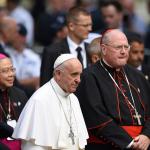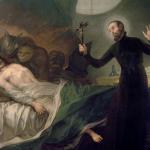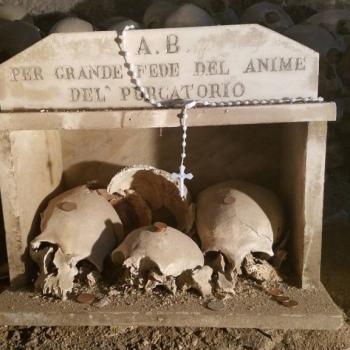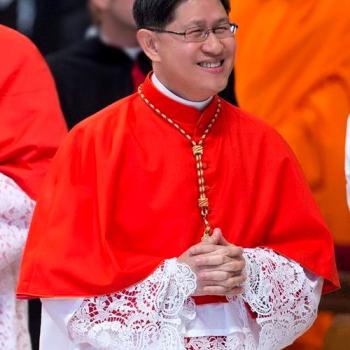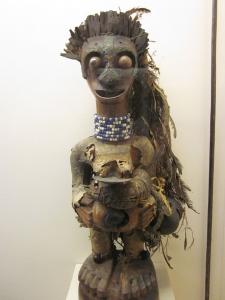
Co-authored by Dr. Kate Kingsbury* and Dr. Andrew Chesnut
One of the major novelties at the 13th annual course for exorcists taking place this week at Regina Apostolorum University in Rome is a section on witchcraft in Africa. Witchcraft is so pervasive in parts of Africa that in 2006 the Catholic bishops of Southern Africa, comprising Bostwana, Swaziland, and South Africa, issued a pastoral letter prohibiting their priests from moonlighting as soothsayers and witch doctors! With the future of both Catholicism and Protestantism in Africa, where demand for exorcism is surging, the Vatican under the first pope from the Global South is sharpening its focus on the continent of its future. Without looking into a crystal ball, but merely by crunching the numbers, one might divine that the future of Christianity is in Africa. According to Pew Research, by 2060 more than four-in-ten sub-Saharan Africans will be Christian, thus leading to a 26% increase from 2015. Of this figure Protestants represent the largest group, at an estimated 57%. In particular, the Pentecostal and Charismatic movements are witnessing momentous growth.
Deliverance and healing ceremonies are one of the most important magnets attracting converts in Africa who on a daily basis are drawn to the dramatic healing rites causing these charismatic churches to mushroom into ever larger and more powerful congregations. It is indubitably awareness of this trend, and a desire to compete with the dynamic Pentecostals and Muslims that has led the Church to prioritize ministries of demonic deliverance across the continent. While the Church has been losing members to Pentecostalism and secularism in Latin America and the latter in Europe, it’s hopeful that it can avoid the same fate in Africa through emphasis on one of its most popular spiritual services – exorcism.
Possession rites have long pervaded the African landscape, originating long before the arrival of Christian missionaries. Across large swaths of the continent, peoples of variegated ethnic origins and creeds have traditionally conducted and still continue to carry out possession rites to rid themselves of evil spirits which they deem responsible for misfortunes and maladies ranging from mental, to physical and financial. Likewise they have since millenia invoked spirits to aid them with healing.
In the horn of Africa, for example, there is a widespread belief in Zar, malevolent spirits that possess people, bringing about destruction and sickness that can only be exorcised through rituals. In Nigeria, people have traditionally consulted babalawo, diviners trained in supernatural skills to remove malicious forces inhabiting their souls. Whilst in South Africa, the spirits of ancestors have long been called upon for their healing powers. Across the continent witchcraft beliefs are a lingua franca to describe and decipher inimical events of all descriptions.
During the colonial era, when vast chunks of the African continent were converted to Christianity by European missionaries, possession rites, spirit ceremonies and notions of witchcraft were not wiped out by the shift in religious belief. Upon colonisation, African notions of the spirit world, sorcery and possession were re-mapped according to a Christian chorography, transcribing local malevolent forces into the Christian world of devils and demons. Autochthonous benevolent spirit forces previously supplicated were transmogrified into petitions to the Holy Spirit, resulting in the widespread popularity of a pneumatocentric form of Christianity across the continent. Hence possession and healing rituals coalesced with Christianity to form novel syncretic spiritual modes, causing the faith to burgeon to new heights.
More recently, influenced by the charismatic movements in the USA, a mixtion of traditional and foreign beliefs as well as practices have spawned new churches in Africa (African Initiated Churches or AICs) that have attracted massive followings, predominantly Pentecostal and Charismatic movements. These churches’ popularity stems primarily from their spiritual offering of deliverance and healing ceremonies which have their origins in the indigenous spiritual landscape. Where previously possession rites and appeals to spirits had been conducted by traditional healers, within Pentecostal and Charismatic churches, deliverance ceremonies are led by clergy and even fellow congregants who invoke the Holy Spirit or cast out demons in healing rituals that are a panacea for all troubles, and rid one of the satanic forces responsible for everything from ill health to financial troubles, weight loss to sex addiction, impotency, kleptomania and homosexuality. Unlike in Catholic churches, no special training is required to perform a healing ceremony and thus with no specific rules nor regulations in place, AICs offering deliverance and healing ceremonies have proliferated across the African continent. Witchcraft ideals perdure within the context of these rites, as the imagined contiguity of sorcery and Satanism entails that people who participate in deliverance rituals are often seen as having been manumitted from witchcraft.
Currently the top ten largest churches in Africa all boast either healing and/or deliverance ceremonies. For example, the Zion Christian Church, in South Africa, has over 3 million members. It is believed that the Lekganyanes, the family who established and still lead this Zionist church are modern manifestations of Moses, prophets who have a direct channel to the Holy Spirit who anoints them with powers during services. Much as in the traditional role of diviners that conducted rituals prior to the arrival of Christianity, these leaders are viewed as seers able to receive the revelations of God and see the sources of sickness within congregants. As prophets the leaders promise an exodus from previous vicissitudes that includes liberation from trouble, sickness, oppression, evil spirits, sorcery and poverty.
Deeper Christian Life Ministry based in Nigeria boasts 65,000 congregants and offers healing ceremonies on a regular basis, whilst Synagogue Church of All Nations (SCOAN), also in Nigeria has, over 400,000 YouTube subscribers and over 50,000 people attend the weekly services. SCOAN’s popularity derives in large part from the weekly deliverance ceremonies that have even featured ‘celebrities’. For example, Richard Kingson’s wife was ostensibly exorcised of a satanic spirit that had prevented her husband, a notable Ghanaian goal keeper, from securing a contract. Whilst the renowned Ghanaian singer Denise Williams was delivered from a demon that had caused her to become suicidal and addicted to drugs. And it is precisely the expulsion of such demons of everyday affliction upon which hinges the future of the Church in Africa.
*Dr. Kate Kingsbury obtained her doctorate in anthropology at the University of Oxford, where she also did her Mphil. Dr. Kingsbury is a polyglot fluent in English, French, Spanish. She is a polymath interested in exploring the intersections between anthropology, religious studies, philosophy, sociology and critical theory. Dr. Kingsbury is Adjunct Professor at the University of Alberta, Canada. She is fascinated by religious phenomena, not only in terms of their continuity across the Holocene and into the Anthropocene but equally interested in the changes wrought to praxis and belief by humans ensuring the infinite esemplasticity that is inherent to all religions, allowing for their inception, survival, alteration, regeneration and expansion across time and space. Dr. Kingsbury is a staunch believer in equal rights and the power of education to ameliorate global disparities. She also works pro bono for a non profit organisation that aims to empower and educate girls in Uganda. Follow Dr. Kingsbury on Twitter


